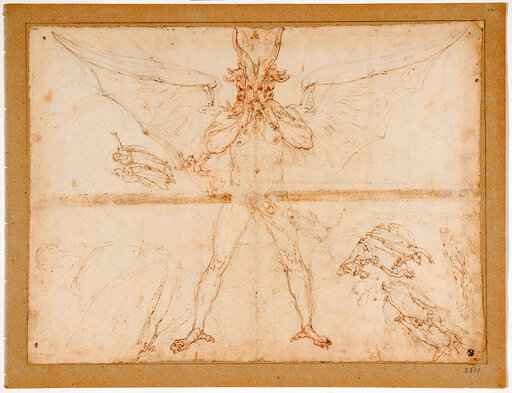
We start with a round of drinks and Japanese gods! Our guest Jason has a few words to say about the popular spiritual figure (God? Not quite? A version of the Buddha?) Jizo. He’s a patron of travellers and children. In our epiosode on the rivers of hell we talked about the Sanzu River, wherethe spirits of children are condemned to stack pebbles to build a tower to heaven, but they can never finish because demons knock them down. Jizo is there to help them out and wrap them in his robes. Generally, he’s a patron of people who suffer in the underworld, so…I’m not sure if we have a place for him in our office. Hmm. But it sounds like we’ll need to talk about his alter-ego Phra Malai someday, a monk who more or less harrowed hell.
Beverage-wise, Victoria recommends “Demonic Tonic,” which is either a light golden style Belgian ale, or a robust medicinal remedy and/or marinade from Happy Pantry. It’s fermented and has onion, lemon, horseradish, habanero, mustard, allspice, and some other things in it. It’s got a skull on the label, so you’ve been warned.



Dante news, which there’s a surprising amount of, but almost always in Italy. The Uffizi gallery has opened a virtual collection of cartoons and sketches by the 16th century artist Federico Zuccari, illustrations from Inferno, Purgatorio, and Paradisio. The exhibit is titled “To See the Stars Again,” and is running…uh…until it isn’t. These pictures are delicate and have only beeen shown twice before, so this is kind of special, particulary if you’re a Dante fan. Article from the Smithsonian with (English) information. (If you’re not a fan, “My God, it’s full of stars” is a line-drop from “2001, A Space Odyssey.”
From the Sandman world, seven cast members have been announced for the series so far. Dispatchist favorites: Gwendoline Christie played Brianne of Tarth in Game of Thrones, and will be taking on the role of Lucifer in the upcomign series…and not for the first time, as she played him in a 2010 production of Doctor Faustus. and Asim Chaudry looks just spot on as Abel, at least in the later versions of the character. Gwendoline is NOTHING LIKE Lucifer in the Wicked and the Divine graphic novel series, who is also somewhat androgynous but in a different direction. (Image at right from CBR.com, “Why Gwendoline Christie is the Perfect Choice to Play Lucifer.”)


And a callout to period-appropriate “Devil Inside” by INXS.
The Satanic Panic
An awful lot of ink and pixels have already been spilled on this topic, a cultural obsession over satanism in the 80s and early 90s, leading to something like 12,000 allegations of cult sexual abuse of children…a number of them targeting daycare employees and educators, parents, and other people that children were close to. Some reading resources: the Wikipedia article is good, Victoria recommends Vox’s excellent articcle, “The History of the Satanic Panic in the US – and Why It’s Not Over Yet.” Jacob leans heavily on Jeffrey Victor’s 1993 Satanic Panic: The Creation of a Contemporary Legend, Norman Cohn’s Europe’s Inner Demons: The Demonization of Christians in Medieval Christendom, and FBI agent Kenneth Lanning’s Guide to Allegations of Childhood Ritual Abuse. The podcast “Conviction” on Gimlet was also helpful, as was Uncover’s short series on same. Incidentally there’s a callout to Cohn in the excellent article that traces the whole blood ritual idea into the weird realm of QAnon conspiracy, Talia Lavin’s “QAnon, Blood Libel, and the Satanic Panic.”
Drawing from Victor’s “Satanic Panic,” he sets up the timetable of the panic more or less as:
1960s-1970s – A stew of rumors of kidnapping and brainwashing from religious cults in the 60s, a general awareness of the power of counterculture, the creation of the Church of Satan, and high-profile occult-flavored crimes (Charles Manson, Son of Sam, etc.). Cattle mutilation scares transition into “Satanists are killing our cattle” stories. “Stranger Danger,” mostly debunked now as a major threat, heavily marketed.
1980: Michelle Remembers published, and repressed memory, multiple personality disorder, and satanic cult survivor stories enter the mainstream.
Early 80s: A few random panics (massively inflated child kidnapping scares, Procter and Gamble Satanism scare) lead to a general haze of low-level threat
1983: First ritual abuse allegations at McMartin Preschool
Mid-80s media expose’s: 20/20 “The Devil Worshippers” (1985), Geraldo Rivera “Devil Worship” (1988)

Procter & Gamble’s 1982 logo
The high point of the satanic panic scare seems to be 1985-1990. The wind-down seems to be a number of factors: rationality seemed to come from a number of sources as the ridiculousness of the accusations grew and became more apparent. The Faith Chapel ritual abuse case in 1991 marked the first major “not guilty” , with amazing accusations (ritual sacrifice of a giraffe and an elephant), and mundane but impossible (a staffer, who because of a genetic disorder wasn’t physically able to drive, accused of driving the children to and from their secret off-site abuse warehouse). Maybe this broke the spell of the “Believe the Children” mindset. Soon after (1994) Lanning released his FBI case studies, and the nation, embarrassed, started to put the entire thing in a box under the bed, although many defendants stayed in prison for years later. One case in Austin, the Oak Hill ritual abuse trial, was tried in 1991, and the defendants were released in 2013, and given an award for damages and a more formal apology in 2017. Later Victoria mentions the nearby San Antonio Four, where four Latina lesbians were jailed based on child testimony in 1998 (!) and acquitted in 2016.
An element of the Satanic Panic prosecutions that gets a strong mention in “Uncover” — spoilers — is that prosecuting a case as “satanic ritual abuse” tended to have poorer results than prosecuting a case as simple sexual abuse, so the wild and crazy elements of the child’s testimony that show the entire thing to be a fabrication simply don’t get mentioned because they’d harm the case.
A challenge in building a defense against the abuse allegations was the powerful “Believe the Children” idea. The groupthink around this concept was strong enough to force rationality out the window. Lanning has a good quote about children: “children rarely lie, but they don’t always tell the truth.” Lanning talks about this a fair bit, as does Victor, and it definitely did a lot to drag the scare out for as many years as it ran.
I wish someone had more information about the “blond hair blue eyes” recurring element, it’s definitely a recurring trope, mentioned in the “uncover” podcast and a few others (1, 2). Kind of the childlike symbol of innocence (as defined by white folks, anyway).
Jason shares a callout to “The Last Gospel of the Pagan Babies,” a shortish documentary on the changing world of southern gay culture and the scene in Lexington, Kentucky. Haven’t found a trailer though 🙁 Jacob follows with a rather more dull book-drop, Elaine Pagel’s “The Origin of Satan: How Christians Demonized Jews, Pagans, and Heretics.” The latter was published in 1996, and must have been quite timely in the fading years of the Satanic scare. Victoria recommends against seeing Javier Bardem’s 2017 “Mother!“
Some talk about ways to sacrifice a baby to Satan. The most popular method, which we can’t find a better name for than “baby-tossing,” is as follows: Satanists (or early Christians, depending on who you ask) throw a baby from cultist to cultist. When the baby finally dies, whoever’s holding the child gets to be in charge of the cult. Another much earlier method was to wrap the child in dough, we are unclear on whether or not the child is to be baked at this stage, but I suspect not because of the bloody nature of the descriptions. Victoria suggests “babies en croute.” I googled for a recipe, or at least instructions, and found “Children en croute,” which is popular among bad guys in Narnia (!), but this particular recipe substitutes ham and veal roast.
Jacob quotes a very fragmented bit from the actually pro-Christian writings of Menucius Felix, from his Octavio, which has some highly speculative thoughts on early Christian worship, and one of the catchier chapter titles:
Chapter 9. Argument: The Religion of the Christians is Foolish, inasmuch as They Worship a Crucified Man, and Even the Instrument Itself of his Punishment. They are Said to Worship the Head of an Ass, and Even the Nature of tTheir Father. They are Initiated by the Slaughter and the Blood of an Infant, and in Shameless Darkness They are All Mixed Up in an Uncertain Medley.
In Europe’s Inner Demons Cohn wraps that diatribe up with the great final quote: “Precisely the secrecy of this evil religion proves that all these things, or practically all, are true.” If that doesn’t summarize the entire Satanic scare, I can’t think of a better quote.
Remember when ABC aired an exorcism? The year was 1991 and apparently most of the hosts don’t remember this one. Relive the magic on Youtube.
A brief pedantry/Male Answer Syndrome apology: Jacob name-checks Victoria, saying that the name of the “good thief” crucified beside Jesus was named “Dismas” the Good Thief. This is correct. He then goes on to correct Victoria on the mount of the crucifixion being not Calvary but Golgotha, it is of course both, and he apologies to all who were saddened, but not perhaps surprised, by this mansplaining. Calvary is actually a transliteration of Golgotha. It means “Skull,” BTW.
It’s a testament to the Internet’s amazing ability to store and retrieve absurdity that I was able to find three different essays on whether or not Jesus and Dracula are the same person. Neither is the same person as retired Wiccan constable Kerr Cuhulain, who had some choice words to say about Michelle Remembers, her therapist’s time in Yoruba and some similarities between what Michelle remembered and African ritual, and…well, it’s a long article. Kuhulain later went on to chair the Officers of Avalon, a group of wiccan law enforcement agents, which is pretty neat.
Chuck Norris in Satanic ritual abuse scare? No really. Well, not really really. For a fun party ice breaker, we recommend “Who’s your recovered memory Satanic ritual abuse celebrity?” It’s fun. Maybe your therapist dredges Chuck Norris out of your repressed recollections. For our hosts, we’ve picked Martha Stewart (she designs the best summoning circles), Lou Ferrigno’s Incredible Hulk, Anne McCaffrey (who isn’t specifically anti-religion as far as I know, but has a Christian background and did exclude religion from Pern), and, logically, musician Bob Seger.
Word of the day: “Legend Trip.” A teen road trip to a destination of some usually scary, usually supernatural, significance. Should be haunted. Ideally at least three people will go. It’s a big, anti-authoritarian road trip rite of passage, and fed the Satanism scare with “satanic” litter and graffiti. Want to know more about investigating occult crimes in your community? The police have some useful instructional films.
Podcast: Play in new window | Download

